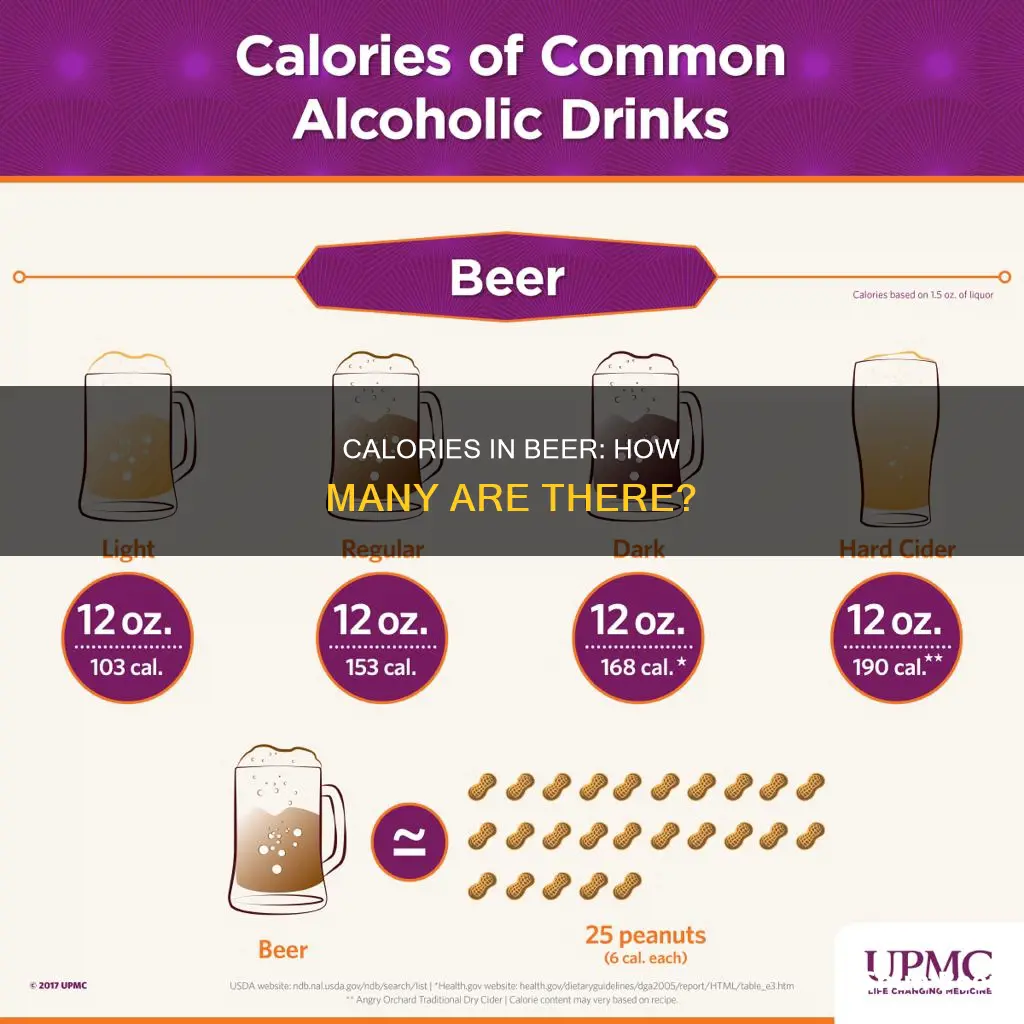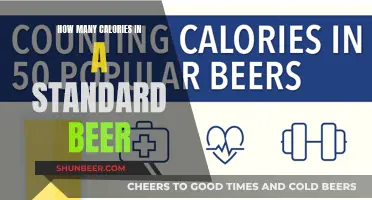
Beer is a popular drink worldwide, but it's important to be aware of its calorie content, especially if you're watching your weight. The number of calories in beer varies depending on the type and maker, but on average, a 12-ounce beer has around 150 calories, similar to a can of Coke. Light beers have fewer calories, ranging from 50 to 100 calories per serving. The calorie content in beer is influenced primarily by its alcohol content, with higher ABV beers containing more calories. For example, a lager with 4.5% ABV has approximately 135 calories, while a barrel-aged stout with 10.5% ABV can have up to 315 calories.
What You'll Learn

Calories in beer range from 50 to 300+ depending on the type and maker
Beer is made from fermented grain, and the calories in beer are mainly composed of carbohydrates and alcohol. The number of calories in beer varies depending on the type and maker, ranging from as few as 50 to over 300.
On average, beer contains around 150 calories. However, the calorie count can be as low as 50 for light beers and over 300 for heavy hitters like IPAs, double or imperial IPAs, and Belgian-style Trippels. The higher the ABV, the more calories in your beer. For example, a lager with 4.5% ABV and 12 oz will have 135 calories, while a 12 oz barrel-aged stout with 10.5% ABV will have 315 calories.
The Dietary Guidelines for Americans recommend no more than one serving of alcohol per day for women and no more than two servings per day for men. A serving is typically defined as 12 ounces of beer with 5% ABV. Non-alcoholic beers are also an option, as they contain less than 0.5% ABV per 12-ounce serving.
When trying to moderate your beer intake, some helpful strategies include drinking a glass of water between alcoholic beverages and using a pre-measured cup to control portion sizes. Opting for non-alcoholic beers or lighter beers with lower ABVs can also help reduce your calorie intake.
Calorie Count in Apple Cider Beer: What's the Damage?
You may want to see also

Beer calories come from alcohol and carbohydrates
Beer is made by fermenting grains such as barley and wheat, which contain carbohydrates. The sugar extracted from these grains is what causes the beer to ferment, and the more sugar present, the more alcohol there will be, and therefore more calories. Beer calories come from two components: alcohol and carbohydrates (starches and sugars from unfermented grains). The calories in beer are mostly influenced by its alcohol content. In general, light beers are lower in both calories and carbohydrates than full-flavoured beers.
The higher the ABV, the more calories in your beer. For example, a 12-ounce lager with an ABV of 4.5% will have around 135 calories, while 12 ounces of a barrel-aged stout with an ABV of 10.5% will have about 315 calories. Beers typically have about 150 calories, whereas light beers range from 50 to 100 calories for a 12-ounce serving.
The Dietary Guidelines for Americans recommend up to one serving of alcohol per day for women and two servings per day for men. A serving is defined as 12 ounces of beer that is five percent ABV. Non-alcoholic beers are another option, with less than 0.5% ABV per 12-ounce serving. However, be aware that you would need to consume ten non-alcoholic beers to equal the amount of alcohol in one regular beer.
If you are watching your carbohydrate intake, you may want to limit your beer consumption or opt for light beers with very few carbs. Drinking fewer calories can also be achieved by choosing 'light' options, drinking water between alcoholic drinks, and avoiding drinking on an empty stomach.
Calories in Moosehead Beer: Nutritional Facts for Beer Enthusiasts
You may want to see also

Alcohol has more calories per 100ml than carbs
The number of calories in a beer depends on several factors, including the alcohol content, the carbohydrate content, and the beer's volume. Typically, a 12-ounce beer with 5% ABV contains around 150 calories.
The calories in beer come primarily from two sources: alcohol and carbohydrates. Alcohol has more calories per 100ml than carbs, and it is the main contributor to the overall calorie count in beer. The higher the ABV, the more calories the beer will have. For example, a lager with 4.5% ABV and 12 ounces will have approximately 135 calories, while a 10.5% ABV stout of the same volume will have about 315 calories.
Light beers, on the other hand, have fewer calories due to their lower alcohol content. They typically range from 50 to 100 calories for a 12-ounce serving. Some very low-alcohol beers, such as Miller 64 with 2% to 3% ABV, can have as few as 60 calories in a 12-ounce serving.
When it comes to carbohydrates in beer, the sugar extracted from barley and grains during the fermentation process contributes to the calorie count. The more sugar present, the more alcohol and, consequently, more calories the beer will have. However, the overall calorie content of a beer is still predominantly influenced by its alcohol content.
Additionally, the type of beer also plays a role in its calorie count. Craft beers, seasonal beers, and those with higher alcohol content tend to have more calories than lighter beers. For example, IPAs and other heavy hitters with 7% to 11% ABV can pack 200 to 300 calories in a standard serving.
In summary, while both alcohol and carbohydrates contribute to the calorie content of beer, alcohol has a higher calorie density, with seven calories per gram compared to four calories per gram for carbohydrates. Therefore, the alcohol content of a beer has a more significant impact on its overall calorie count.
Pickle Beer Calories: Best Maid's Nutritional Breakdown
You may want to see also

Light beers have fewer calories
Beer is not exactly a nutritional powerhouse, but that doesn't stop us from drinking it! The number of calories in beer varies depending on the type of beer and its maker. Typically, a beer will have around 150 calories, but this can range from 95 to 315 calories for a 12-ounce serving. The calorie content is influenced primarily by the alcohol content, with the general rule being that the higher the ABV, the more calories in your beer. For example, a 12-ounce lager with 4.5% ABV will have around 135 calories, whereas a 12-ounce barrel-aged stout with 10.5% ABV will have a hefty 315 calories.
Light beers, however, tend to have fewer calories. They achieve this by having a lower alcohol content. A light beer will typically have between 50 and 100 calories for a 12-ounce serving. Very low-alcohol beers, with an ABV of 2% to 3%, can have as few as 60 calories, while most light beers with an ABV of 4% will have around 100 calories. For example, Bud Light has 110 calories, and Busch Light has 95 calories.
If you're watching your weight, opting for a light beer can be a good way to save on calories. However, it's important to keep in mind that alcohol is calorie-dense, with 7 calories per gram, and those calories are treated even worse by the body than ice cream calories. Alcohol has a metabolic quirk where it is preferentially stored as fat rather than used for energy. So, even if you opt for a light beer, it's still easy to start packing on the pounds if you're not careful.
If you're looking for the lowest-calorie options, non-alcoholic beers are the way to go. With less than 0.5% ABV, you would have to drink 10 non-alcoholic beers to equal the amount of alcohol in one regular beer. So, if you're counting calories, a non-alcoholic beer is a great choice, as long as you're happy with a very low ABV.
Calories in a Grapefruit Shandy Beer: A Nutritional Overview
You may want to see also

Calories in beer are best influenced by alcohol content
Beer is made from fermented grain, and the calories in beer are mainly derived from carbohydrates and alcohol. The calorie content of beer varies depending on the type and maker. Typically, a 12-ounce beer has around 150 calories, while light beers range from 50 to 100 calories per serving. The alcohol content is the primary factor influencing the calorie count in beer.
The higher the ABV (alcohol by volume), the more calories a beer will contain. For example, a lager with 4.5% ABV and 12 oz. will have approximately 135 calories, whereas a 12 oz. barrel-aged stout with 10.5% ABV will have 315 calories. This relationship between ABV and calories can be calculated using the formula: ABV% x 2.5 x ounces of beer.
Light beers, which have lower alcohol content, tend to have fewer calories. Very low-alcohol beers, such as Miller 64 (2% to 3% ABV), start at around 60 calories per 12 oz. Most light beers (around 4% ABV) have about 100 calories. Non-alcoholic beers, which have less than 0.5% ABV, are another option for those watching their calorie intake.
Craft beers, seasonal beers, and beers with higher alcohol content generally have more calories than lighter varieties. For instance, IPAs and other heavy hitters (7% to 11% ABV) can pack 200 to 300 calories per serving. However, a lower-alcohol "session" IPA can bring the calorie count down to around 140.
When it comes to calorie content, beer can vary significantly. While a standard 12-ounce serving of popular American beers ranges from 95 to 150 calories, some beers can have twice as many calories. For those mindful of their calorie intake, it's important to note that the alcohol content of beer is the main factor influencing its calorie count.
Calorie Count in Harp Beer: Nutritional Facts Explained
You may want to see also
Frequently asked questions
The number of calories in a beer depends on the type of beer and the serving size. A typical 12-ounce beer has around 150 calories, which is similar to a can of Coke. Light beers have fewer calories, ranging from 50 to 100 calories per serving.
The calorie content of beer is influenced primarily by its alcohol content, with higher ABV beers containing more calories. The type of beer, such as craft or seasonal beers, can also affect the calorie count, with higher-alcohol beers tending to have more calories.
Beer tends to have a higher number of calories compared to wine or spirits like whiskey. For example, a 6-ounce pour of red or white wine has around 150 calories, while a typical liquor shot has 100-120 calories.
Yes, opting for non-alcoholic or light beers can help reduce calorie intake. Non-alcoholic beers typically have fewer calories, and light beers can range from 50 to 100 calories per 12-ounce serving. Additionally, drinking water between alcoholic beverages and using pre-measured cups can help moderate your intake.







